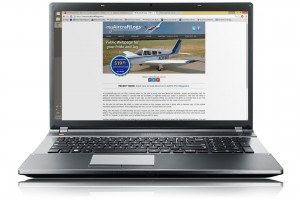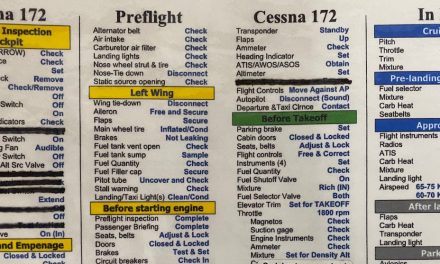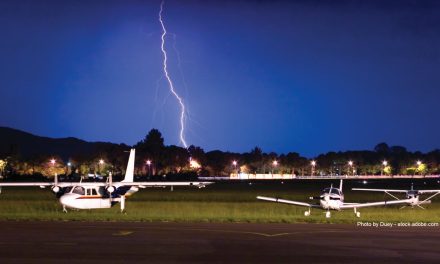 MyAircraftLogs and the Evolution of Logging
MyAircraftLogs and the Evolution of Logging
By Max Lundin
Whether used by fishermen to boast about their latest catch or by Captain Kirk to describe where he has boldly gone; the logbook is a tool that the pilot of any vessel or user of any technical equipment must update religiously. In the case of the aviation industry, correct use of a logbook is both a legal and moral concern, as it is the strongest indicator of condition that an aircraft owner can have. However, since the dawn of the digital era, the methods in which one can record logs has transformed from pencil and parchment to online systems and interfaces. Today a new logbook system called myAircraftLogs makes the logbook digital, resulting in an easier logging process and a safer way to keep records for current and future owners.
Logbook Etiquette and Collaboration: The Bane of Pen and Paper Log Books
In short, a logbook is your plane’s identity. From a serious engine overhaul to simple oil filter changes, every detail is recorded so that the owner (and future owners) knows what has been done and what has the most potential to go awry in the future. While there is no pilot who wouldn’t look after their logbook with the utmost care, mistakes can and do happen. A lost, stolen, or destroyed logbook can be a serious calamity, potentially resulting in a plane that is no longer airworthy by FAA standards. In addition to being your plane’s identity, the logbook is also your main form of credibility in regards to its past and present condition and holds a hefty value in regards to communicating with buyers and insurance companies.
A clean, neatly-kept logbook is an often undervalued requisite that many pilots do not consider when doing their logs. Ideally, a pilot will keep the logbook as professional-looking as possible. Regardless, “doctor scrawl” and wrinkled pages due to human error or neglect become inevitable—especially in scenarios involving multiple pilots/owners. While it may be “cute” for a pilot to write in a manuscript that only he or she understands, it won’t be so cute when an owner is collaborating with peers, working with a maintenance shop, or trying to sell the plane!
Another issue that often arises is the consolidation of multiple logbooks. When considering separate entries for avionics, propellers, and engines, along with the frequency and length associated with a pilot’s individual logs, a plane may have as many as a dozen logbooks. This multitude of logbooks only increases the odds of losing part of your plane’s history, especially when you consider how long a logbook may be in the possession of an owner. The act of actually finding a particular log entry has an equal or greater degree of difficulty, depending on the neatness of a logbook and how long it is.
Insured with Lost or Missing Logbooks?
In the event of an insurance claim, providers request and meticulously examine logbooks as one of their most powerful instruments to measure the case. Although your avionics, airframe, and engine modifications have been recorded within your policy statement, inadequate logbook records can make it difficult for a claim to be awarded. Such negligence may not only result in a deep hole in your wallet, but under some policies your insurance coverage may be nullified—even after you have paid the premium.
Time to Sell?
When an educated buyer looks at an aircraft, they often have a list of criteria that they want to address before signing the bottom line. Serious buyers will even hire an inspector to give the plane a last onceover before making the purchase. An examination of your plane’s logbook is an important part of this process and the quality of your logbook can ultimately affect the value of your aircraft. The logbook should easily answer most technical questions regarding total flight hours, repairs, overhauls, and general airworthiness, while also highlighting any historic issues with the plane that the buyer will undoubtedly be curious about. If you’ve been a caring and meticulous pilot, you’ve got nothing to worry about. However, if you’ve slacked off on keeping proper logs over the course of your 25-year history with the plane, you may be cheating yourself out of well-deserved cash.
MyAircaftLogs offers Peace of Mind for Aircraft Owners
As discussed, there are a number of issues associated with improper logging; and the results of negligent logging or, worse yet, losing a logbook, can be catastrophic. Fortunately, myAircraftLogs offers a proactive solution.
Instead of leaving it to chance that your “library” of logbooks is safe, myAircraftLogs takes chance out of the equation by securely storing your information online. For $19.95 a year, you can easily record all of your log entries through a comprehensive online logbook system. With a virtual backup system, you have guaranteed peace of mind that your logbooks will be safe and that your plane will continue to be airworthy.
The system addresses many of the inherent issues associated with logging—most notably, lost logbooks! And thanks to the clean online interface, there’s no need to worry about sloppy handwriting or crinkled pages that sometimes make the process of analyzing a plane so difficult. Plus, search queries can be used to quickly locate specific dates or events that you are looking for when doing an evaluation, and the site’s calendar allows you to track and schedule important dates (like maintenance and medicals) for both you and your aircraft.
The website also offers extended accessibility allowing you to share your aircraft’s information with mechanics, potential buyers, or insurers on either a full-disclosure or read-only basis, thus saving time and hassle for both you and the buyer/insurer.
MyAircraftLogs also offers professionally-bound, physical logbooks. These logbooks can simplify and tidy-up the old-school process of throwing your logbook onto a photocopier and hoping you end up with legible facsimiles of your records. You can use them in your personal library for a physical hardcopy of your records, or give them to prospective buyers when it’s time to say “goodbye” to your plane.
MyAircraftLog’s most personal feature offers the user the ability to create a personalized webpage for his plane. The user can upload pictures of the aircraft and its changes over time, as well as, information and photos about themselves or even previous owners who have flown it in the past. Beyond pictures of the aircraft and its owners, the site gives you space to tell your story and the story of your beloved plane. The personal page serves as a testament to the owner’s love of flying, a key element that myAircraftLogs takes into consideration.
Accessibility to these pages is completely public—all you need is a plane’s tail number and you can view its story. The site has a tail number input page from which you can plug in the tail number and find information about whichever plane interests you. By being so accessible, myAircraftLogs serves as a simple marketing tool when you’re selling your plane, leaving you with the task of distributing nothing more than your tail number. It also serves as an easy way to share the history and story of your aviation career with friends and family, without driving them down to the hangar.
The Experience of Online Logging
Beyond being legally required by the FAA, the logbook is of significant personal value to its owner, as it recounts the entire lifespan of a plane. An online logbook system not only ensures that valuable information is easily maintained and safely stored; but by making the process of logging a truly collaborative and cumulative experience, myaircraftlog can virtually guarantee that a plane’s history will never be lost. In short, myAircraftLogs simplifies the process of owning an aircraft by organizing and storing a variety of valuable information in one place.





